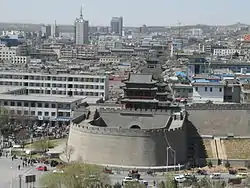Xi'an
Xi'an (UK: /ʃiːˈæn/ shee-AN, US: /ʃiːˈɑːn/ shee-AHN;[2][3][4][5] Chinese: 西安; pinyin: Xī'ān; Chinese: [ɕí.án] ⓘ), alternatively romanized as Xian, Hsi-an, or Sian, is the capital of Shaanxi Province. A subprovincial city on the Guanzhong Plain,[6] the city is the third most populous city in Western China, after Chongqing and Chengdu, as well as the most populous city in Northwest China.[7] Its total population was 12,952,907 as of the 2020 census. The total urban population was 9.28 million.[8]
Xi'an
西安市 Hsi-an, Sian | |
|---|---|
Clockwise from top left: Drum Tower; Giant Wild Goose Pagoda; Bell Tower; Tang Paradise at night; and City wall of Xi'an | |
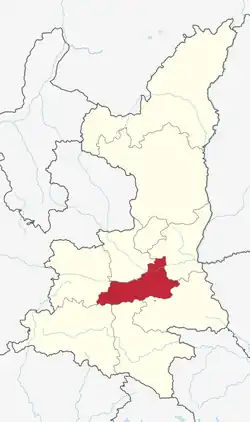 Location of Xi'an City jurisdiction in Shaanxi | |
 Xi'an Location in China | |
| Coordinates (Shaanxi provincial government): 34°15′40″N 108°56′32″E | |
| Country | China |
| Province | Shaanxi |
| Municipal seat | Weiyang District |
| Government | |
| • Type | Subprovincial city |
| • Body | Xi'an Municipal People's Congress |
| • CCP Secretary | Wang Hao |
| • Congress Chairman | Hu Runze |
| • Mayor | Li Mingyuan |
| • CPPCC Chairman | Yue Huafeng |
| Area | |
| • Subprovincial and prefecture-level city | 10,762 km2 (4,155 sq mi) |
| • Urban | 5,808.6 km2 (2,242.7 sq mi) |
| • Metro | 4,903.9 km2 (1,893.4 sq mi) |
| Elevation | 405 m (1,329 ft) |
| Population (2020 census)[1] | |
| • Subprovincial and prefecture-level city | 12,952,907 |
| • Density | 1,200/km2 (3,100/sq mi) |
| • Urban | 11,904,805 |
| • Urban density | 2,000/km2 (5,300/sq mi) |
| • Metro | 12,283,922 |
| • Metro density | 2,500/km2 (6,500/sq mi) |
| Time zone | UTC+8 (CST) |
| Postal code | 710000–710090 |
| Area code | 29 |
| ISO 3166 code | CN-SN-01 |
| GDP | (2020) |
| – Total | CNY1002 billion (US$154.2 billion) |
| – Per capita | CNY98205 (US$15,108) |
| License plate prefixes | 陕A,陕U |
| City Flower | Pomegranate flower |
| City Tree | Pagoda tree |
| Website | XA.gov.cn |
| Xī'ān | |||||||||||||||||||||||||||||||||
|---|---|---|---|---|---|---|---|---|---|---|---|---|---|---|---|---|---|---|---|---|---|---|---|---|---|---|---|---|---|---|---|---|---|
"Xi'an" in Chinese characters | |||||||||||||||||||||||||||||||||
| Chinese name | |||||||||||||||||||||||||||||||||
| Chinese | 西安 | ||||||||||||||||||||||||||||||||
| Postal | Sianfu | ||||||||||||||||||||||||||||||||
| Literal meaning | "Western Peace" | ||||||||||||||||||||||||||||||||
| |||||||||||||||||||||||||||||||||
| Cháng'ān | |||||||||||||||||||||||||||||||||
| Simplified Chinese | 长安 | ||||||||||||||||||||||||||||||||
| Traditional Chinese | 長安 | ||||||||||||||||||||||||||||||||
| Literal meaning | "Perpetual Peace" | ||||||||||||||||||||||||||||||||
| |||||||||||||||||||||||||||||||||
| Xi'an dialect (Zhongyuan Mandarin) name | |||||||||||||||||||||||||||||||||
| Xi'an dialect (Zhongyuan Mandarin) | 西安: [ɕi²¹.ŋã²¹] 長安: [ʈ͡ʂʰaŋ²⁴.ŋã²¹] | ||||||||||||||||||||||||||||||||
Since the 1980s, as part of the economic growth of inland China especially for the central and northwest regions, Xi'an has re-emerged as a cultural, industrial, political and educational center of the entire central-northwest region, with many facilities for research and development. Xi'an currently holds sub-provincial status, administering 11 districts and 2 counties.[9] In 2020, Xi'an was ranked as a Beta- (global second tier) city by the Globalization and World Cities Research Network,[10] and, according to the country's own ranking, ranked 17th.[11] Xi'an is also one of the world's top 100 financial centers, according to the Global Financial Centres Index.[12] Xi'an is ranked in the top 30 cities in the world by scientific research output as tracked by the Nature Index,[13] and home to multiple prestigious educational institutions in Northwest China, such as Xi'an Jiaotong University, Northwestern Polytechnical University, Xidian University and Northwest University.[14][15]
Known as Chang'an (Chʻang-an) in much of its history, Xi'an is one of the Chinese Four Great Ancient Capitals, having held the position under several of the most important dynasties in Chinese history,[16] including Western Zhou, Western Han, Sui, Northern Zhou and Tang.[16] Xi'an is now the second most popular tourist destination in China.[17] The city is the starting point of the Silk Road and home to the Terracotta Army of Emperor Qin Shi Huang, both of which are listed as UNESCO World Heritage sites.[18]
Name
"Xi'an" is the atonal pinyin romanization of the Mandarin pronunciation of its name 西安, which means "Western Peace" in Chinese. (The apostrophe – known in Chinese as a 隔音符號, géyīn fúhào – should be included to distinguish its pronunciation from the single syllable xian.) The name was adopted in 1369 under the early Ming dynasty. Jesuit missionaries recorded its name as "Si-ngan" or "Si-ngan-fou"[19] from its status as the seat of a prefecture (府, fǔ). This form still appears in the Latin name of the Catholic diocese of Xi'an, archidioecesis Singanensis. The name was later romanized as "Hsi-an" by Wade & Giles and as "Sianfu"[20] or "Sian"[18] by the Qing imperial post office, both of which were common until the general adoption of pinyin.
The area of present-day Xi'an has been the site of several important former Chinese cities. The capital of the Western Zhou were the twin cities of Feng and Hao, known collectively as Fenghao, located on opposite banks of the Feng River at its confluence with the southern bank of the Wei in the western suburbs of present-day Xi'an.[21] The Qin capital Xianyang was erected north of the Wei during the Warring States period and was succeeded by the Western Han capital of Chang'an (長安), meaning "Perpetual Peace", which was located south of the Wei and covered the central area of present-day Xi'an. During the Eastern Han, Chang'an was also known as the "Western Capital" (西京), named for its namesake position relative to the main capital at Luoyang. Under the Sui, its name became Daxing (大興, "Greatly Prosperous") in AD 581. Under the Tang, the name reverted to Chang'an in 618.[18] Under the Mongolian Yuan dynasty (13th & 14th centuries), it held a succession of names: Fengyuan (奉元), Anxi (安西, "Peaceful West") and Jingzhao (京兆). The Ming name "Xi'an" was changed back to Xijing ("Western Capital", as above) between 1930 and 1943.
History
Prehistory
The Lantian Man was discovered in 1963 in Lantian County, 50 km (31 mi) southeast of Xi'an, and dates back to at least 500,000 years before the present time. A 6,500-year-old Neolithic village, Banpo, was discovered in 1953 on the eastern outskirts of the city proper, which contains the remains of several well organized Neolithic settlements carbon dated to 5,600–6,700 years ago.[22][23][24][25] The site is now home to the Xi'an Banpo Museum, built in 1957 to preserve the archaeological collection.[26]
Ancient era
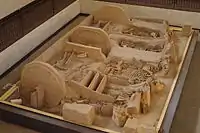
Xi'an became a cultural and political center of China in the 11th century BC with the founding of the Zhou dynasty. The capital of Zhou was established in the twin settlements of Fengjing (灃京) and Haojing (鎬京), together known as Fenghao, located southwest of contemporary Xi'an. The settlement was also known as Zōngzhōu (宗周) to indicate its role as the capital of the vassal states.[27] In 738 BC, King Ping of Zhou moved the capital to Luoyang due to political unrest.[28][29]
Imperial era

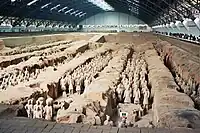
Following the Warring States period, China was unified under the Qin dynasty (221–206 BC) for the first time, with the capital located at Xianyang, just northwest of modern Xi'an.[30] The first emperor of China, Qin Shi Huang ordered the construction of the Terracotta Army and his mausoleum just to the east of Xi'an almost immediately after his ascension to the throne.[31]
In 202 BC, the founding emperor Liu Bang of the Han dynasty established his capital in Chang'an County; his first palace, Changle Palace (長樂宮, "Perpetual Happiness") was built across the river from the ruin of the Qin capital. This is traditionally regarded as the founding date of Chang'an. Two years later, Liu Bang built Weiyang Palace (未央宮, "Never Ending Palace") north of modern Xi'an. Weiyang Palace was the largest palace ever built on Earth, covering 4.8 square kilometers (1,200 acres), which is 6.7 times the size of the current Forbidden City and 11 times the size of the Vatican City.[32] The original Xi'an city wall was started in 194 BC and took 4 years to finish. Upon completion, the wall measured 25.7 km (15.97 mi) in length and 12 to 16 m (39.37–52.49 ft) in thickness at the base, enclosing an area of 36 km2 (13.90 sq mi). In the year 190, amidst uprisings and rebellions just prior to the Three Kingdoms Period, Dong Zhuo, a powerful warlord from nearby Xiliang, moved the court from Luoyang to Chang'an in a bid to avoid a coalition of other powerful warlords against him.
Following several hundred years of unrest, the Sui dynasty reunified China in 582. The emperor of Sui ordered a new capital to be built southeast of the Han capital, called Daxing. It consisted of three sections: the Imperial City, the palace section, and the civilian section, with a total area of 84 km2 (32 sq mi) within the city walls. At the time, it was the largest city in the world. The city was renamed Chang'an by the Tang dynasty.[33] In the mid-7th century, after returning from his pilgrimage to India, the Buddhist monk Xuanzang established a translation school for Sanskrit scriptures.
Construction of the Giant Wild Goose Pagoda began in 652. This pagoda was 64 m (209.97 ft) in height, and was built to store the translations of Buddhist sutras obtained from India by Xuanzang. In 707, construction of the Small Wild Goose Pagoda began. This pagoda measured 45 m (147.64 ft) tall at the time of completion, and was built to store the translations of Buddhist sutras by Yijing. The massive 1556 Shaanxi earthquake eventually damaged the tower and reduced its height to 43.4 m (142.39 ft).[34]
The Nestorian Stele is a Tang Chinese stele erected in 781 that documents 150 years of early Christianity in China.[35] It is a 279 cm tall limestone block with text in both Chinese and Syriac describing the existence of Christian communities in several cities in northern China. It reveals that the initial Nestorian Christian church had met recognition by the Tang Emperor Taizong, due to efforts of the Christian missionary Alopen in 635.[36]
Chang'an was devastated at the end of the Tang dynasty in 904. Residents were forced to move to the new capital city in Luoyang. Only a small area in the city continued to be occupied thereafter. During the Ming dynasty, a new wall was constructed in 1370 and remains intact to this day. The wall measures 11.9 km (7.4 mi) in circumference, 12 m (39.37 ft) in height, and 15 to 18 m (49.21–59.06 ft) in thickness at the base; a moat was also built outside the walls. The new wall and moat would protect a much smaller city of 12 km2 (4.6 sq mi).
Modern era

The Qing dynasty established a walled off Manchu banner quarter in northeast Xi'an, on the site of the former palace of the Ming Prince of Qin. A Han banner quarter was established in the southeast of the city.
Manchu bannermen from the Xi'an banner garrison were praised for maintaining Manchu culture by Kangxi in 1703.[37] Xi'an garrison Manchus were said to retain Manchu culture far better than all other Manchus at martial skills in the provincial garrisons and they were able to draw their bows properly and perform cavalry archery, unlike Beijing Manchus. The Qianlong emperor received a memorial staying Xi'an Manchu bannermen still had martial skills, although not up to those, in the past in a 1737 memorial from Cimbu.[38] By the 1780s, the military skills of Xi'an Manchu bannermen dropped enormously, and they had been regarded as the most militarily skilled provincial Manchu banner garrison.[39] Manchu women from the Xi'an garrison often left the walled Manchu garrison and went to hot springs outside the city, and gained bad reputations for their sexual lives. A Manchu from Beijing, Sumurji, was shocked and disgusted by this after being appointed Lieutenant general of the Manchu garrison of Xi'an and informed the Yongzheng emperor what they were doing.[40][41] Han civilians and Manchu bannermen in Xi'an had bad relations, with the bannermen trying to steal at the markets. Manchu Lieutenant general Cimbru reported this to Yongzheng emperor in 1729, after he was assigned there. Governor Yue Rui of Shandong was then ordered by the Yongzheng to report any bannerman misbehaving and warned him not to cover it up in 1730, after Manchu bannermen were put in a quarter in Qingzhou.[42] Manchu bannermen from the garrisons in Xi'an and Jingzhou fought in Xinjiang in the 1770s and Manchus from Xi'an garrison fought in other campaigns against the Dzungars and Uyghurs throughout the 1690s and 18th century. In the 1720s Jingzhou, Hangzhou, and Nanjing Manchu banner garrisons fought in Tibet.[43]
For the over 200 years they lived next to each other, Han civilians and Manchu bannermen of both genders in Xi'an did not intermarry with each other at all. The Qing dynasty altered its law on intermarriage between Han civilians and Manchu bannermen several times in the dynasty. At the beginning of the Qing dynasty, the Qing allowed Han civilians to marry Manchu women. Then the Qing banned civilians from marrying women from the Eight banners later. In 1865, the Qing allowed Han civilian men to marry Manchu bannerwomen in all garrisons, except the capital garrison of Beijing. There was no formal law on marriage between people in the different banners, like the Manchu and Han banners, but it was informally regulated by social status and custom. In northeastern China, such as Heilongjiang and Liaoning, it was more common for Manchu women to marry Han men, since they were not subjected to the same laws and institutional oversight as Manchus and Han in Beijing and elsewhere.[44]
In a book published in 1911, American sociologist Edward Alsworth Ross wrote of his visit to Xi'an just before the Xinhai revolution: "In Sianfu the Tartar quarter is a dismal picture of crumbling walls, decay, indolence and squalor. On the big drill grounds you see the runways along which the horseman gallops and shoots arrows at a target while the Tartar military mandarins look on. These lazy bannermen were tried in the new army, but proved flabby and good-for-nothing; they would break down on an ordinary twenty-mile march. Battening on their hereditary pensions, they have given themselves up to sloth and vice, and their poor chest development, small weak muscles, and diminishing families foreshadow the early dying out of the stock. Where is there a better illustration of the truth that parasitism leads to degeneration?".[45] Ross spoke highly of the Han and Hui population of Xi'an, Shaanxi and Gansu in general, saying: "After a fortnight of mule litter we sight ancient yellow Sianfu, "the Western capital", with its third of a million souls. Within the fortified triple gate the facial mold abruptly changes and the refined intellectual type appears. Here and there faces of a Hellenic purity of feature are seen and beautiful children are not uncommon. These Chinese cities make one realize how the cream of the population gathers in the urban centers. Everywhere town opportunities have been a magnet for the élite of the open country."[46]
In October 1911, during the Xinhai revolution, revolutionaries stormed the Manchu fort in Xi'an. Most of the city's 20,000 Manchus were killed.[47][48] Hui (Muslims; then referred to as "Mohammedans") were divided in its support for the revolution. Those of Shaanxi supported the revolutionaries, while those of Gansu supported the Qing. The Hui of Xi'an (Shaanxi province) joined the Han Chinese revolutionaries in slaughtering the Manchus.[49][50][51] Some wealthy Manchus survived by being ransomed. Wealthy Han Chinese enslaved Manchu girls[52] and poor Han Chinese troops seized young Manchu women as wives.[53] Hui Muslims also seized young pretty Manchu girls and raised them as Muslims.[54]
A British missionary who witnessed the massacre commented that "Old and young, men and women, children alike, were all butchered... Houses were plundered and then burnt; those who would fain have laid hidden till the storm was past, were forced to come out into the open. The revolutionaries, protected by a parapet of the wall, poured a heavy, unceasing, relentless fire into the doomed Tartar (Manchu) city, those who tried to escape thence into the Chinese city were cut down as they emerged from the gates."[47][55]
In 1936, the Xi'an (then "Sian") Incident took place in the city during the Chinese Civil War. The incident brought the Kuomintang (KMT) and Chinese Communist Party to a truce in order to concentrate on fighting against the Japanese Invasion.[56]
On March 11, 1938, an aerial battle broke out for the first time over Xi'an as Imperial Japanese Army Air Force aircraft attacked the city, and was engaged by Chinese Air Force I-15 fighter planes, led by Lt. Cen Zeliu of the 5th Pursuit Group, 17th Squadron.[57] While repeatedly attacked by air, Shaanxi was heavily fortified by units of the Eighth Route Army; Xi'an was never taken by the Japanese forces.[58]
On May 20, 1949, the Communist-controlled People's Liberation Army captured the city of Xi'an from the Kuomintang force.[59]
During the Mao era, Xi'an was further developed as part of the Third Front Construction.[60]: 186
Xi'an made headlines for being one of the many cities where the 2012 China anti-Japanese demonstrations occurred.[61][62][63]
In 2022, Xi'an witnessed the largest COVID-19 community outbreak since the initial months of the pandemic hit China.[64] From December 23, 2021, the city was put into strict lockdown after local authorities reported more than 250 cases,[65] traced to the Delta variant by authorities.[66] This led to stressed healthcare and delayed or insufficient food deliveries to some part of the city.[67] Restrictions of Xi'an were lifted on January 24.[68]
Geography
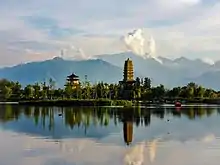
Xi'an lies on the Guanzhong Plain in the south-central part of Shaanxi province, on a flood plain created by the eight surrounding rivers and streams.
The city borders the northern foot of the Qin Mountains (Qinling) to the south, and the banks of the Wei River to the north. Hua Shan, one of the five sacred Taoist mountains, is located 100 km (62 mi) away to the east of the city. Not far to the north is the Loess Plateau.
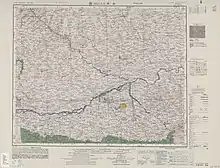
At the beginning of Han dynasty, the Chief of Staff Zhang Liang advised the emperor Liu Bang to choose Guanzhong as the capital of the Han dynasty: "Guanzhong Plain is located behind Mount Xiao and Hangu Pass, and connects Long (Gansu) and Shu (Sichuan). The area can be called an irony castle spreads for thousands of miles, and is rich in harvest like the nation of heaven." (关中左崤函,右陇蜀,沃野千里,此所谓金城千里,天府之国也) Since then, Guanzhong is also known as the 'Nation of the Heaven'.[69]
Climate
Xi'an has a temperate climate that is influenced by the East Asian monsoon, classified under the Köppen climate classification as situated on the borderline between a semi-arid climate (BSk) and humid subtropical climate (Cwa). The Wei River valley is characterized by hot, humid summers, cold, dry winters, and dry springs and autumns. Most of the annual precipitation is delivered from July to late October. Snow occasionally falls in winter but rarely settles for long. Dust storms often occur during March and April as the city rapidly warms up. Summer months also experience frequent but short thunderstorms. The monthly 24-hour average temperature ranges from around the freezing mark in January to 27.0 °C (80.6 °F) in July, with an annual mean of 14.08 °C (57.3 °F). Extremes since 1951 have ranged from −20.6 °C (−5 °F) on January 11, 1955, to 41.8 °C (107 °F) on June 21, 1998. A highest record of 42.9 °C (109 °F) was registered in another station on June 17, 2006.[70][71]
| Climate data for Xi'an (Chang'an District), 1991–2020 normals, extremes 1951–2013 | |||||||||||||
|---|---|---|---|---|---|---|---|---|---|---|---|---|---|
| Month | Jan | Feb | Mar | Apr | May | Jun | Jul | Aug | Sep | Oct | Nov | Dec | Year |
| Record high °C (°F) | 17.0 (62.6) |
24.1 (75.4) |
31.3 (88.3) |
34.9 (94.8) |
38.6 (101.5) |
41.8 (107.2) |
41.0 (105.8) |
40.0 (104.0) |
38.5 (101.3) |
34.1 (93.4) |
24.5 (76.1) |
21.6 (70.9) |
41.8 (107.2) |
| Average high °C (°F) | 5.0 (41.0) |
9.3 (48.7) |
15.5 (59.9) |
22.1 (71.8) |
26.9 (80.4) |
31.7 (89.1) |
32.8 (91.0) |
30.7 (87.3) |
25.4 (77.7) |
19.3 (66.7) |
12.6 (54.7) |
6.6 (43.9) |
19.8 (67.7) |
| Daily mean °C (°F) | −0.5 (31.1) |
3.3 (37.9) |
9.0 (48.2) |
15.1 (59.2) |
20.0 (68.0) |
24.9 (76.8) |
26.9 (80.4) |
25.0 (77.0) |
19.9 (67.8) |
13.7 (56.7) |
6.9 (44.4) |
1.1 (34.0) |
13.8 (56.8) |
| Average low °C (°F) | −4.4 (24.1) |
−1.1 (30.0) |
3.9 (39.0) |
9.2 (48.6) |
13.9 (57.0) |
18.7 (65.7) |
21.7 (71.1) |
20.5 (68.9) |
15.8 (60.4) |
9.8 (49.6) |
2.8 (37.0) |
−2.7 (27.1) |
9.0 (48.2) |
| Record low °C (°F) | −20.6 (−5.1) |
−18.7 (−1.7) |
−7.6 (18.3) |
−4 (25) |
3.5 (38.3) |
9.2 (48.6) |
15.1 (59.2) |
12.1 (53.8) |
4.8 (40.6) |
−1.9 (28.6) |
−16.8 (1.8) |
−19.3 (−2.7) |
−20.6 (−5.1) |
| Average precipitation mm (inches) | 8.8 (0.35) |
13.3 (0.52) |
28.4 (1.12) |
49.6 (1.95) |
68.0 (2.68) |
85.6 (3.37) |
103.8 (4.09) |
96.7 (3.81) |
117.2 (4.61) |
66.6 (2.62) |
27.9 (1.10) |
6.5 (0.26) |
672.4 (26.48) |
| Average precipitation days (≥ 0.1 mm) | 4.0 | 4.7 | 7.2 | 7.8 | 9.8 | 9.1 | 10.8 | 10.4 | 12.3 | 11.0 | 6.1 | 3.5 | 96.7 |
| Average snowy days | 4.7 | 3.7 | 1.3 | 0.1 | 0.1 | 0 | 0 | 0 | 0 | 0 | 1.3 | 2.8 | 14 |
| Average relative humidity (%) | 67 | 67 | 65 | 66 | 66 | 63 | 70 | 76 | 80 | 80 | 77 | 69 | 71 |
| Mean monthly sunshine hours | 120.2 | 121.4 | 160.2 | 185.1 | 200.1 | 201.2 | 209.3 | 176.1 | 135.2 | 119.8 | 120.6 | 121.7 | 1,870.9 |
| Percent possible sunshine | 38 | 39 | 43 | 47 | 46 | 47 | 48 | 43 | 37 | 35 | 39 | 40 | 42 |
| Source: China Meteorological Administration[72][73][74] all-time extreme temperature[71] | |||||||||||||
National Time Service Center
The Shaanxi Astronomical Observatory was established in 1966. In 1975, according to the Geodetic Origin Report of the People's Republic of China, 'in order to avoid bias in the mensuration as much as possible, the Geodetic Origin would be in central mainland China.' Lintong (临潼), a town near Xi'an was chosen. Since 1986, Chinese Standard Time (CST) was set from NTSC. The National Time Service Center (NTSC), the Chinese Academy of Sciences is an institute which is mainly engaged in the service and research on time and frequency. NTSC takes charge of generating and maintaining the national standard time scale, disseminating the time and frequency signals. The autonomous standard time scales of universal time and atomic time and the dissemination techniques with LF radio and HF radio were established successively during the 1970s and 1980s, which meet all the requirements for different applications on the whole, such as the scientific researches, national economy, etc.[75]
Demographics
As of 2010 Xi'an has a population of 5.4 million.[76] Compared to the census data from 2007, the population has increased by 1.4 million persons.[77] The population is 51.66 percent male and 48.34 percent female.[77] Among its districts, Yanta has the largest population, with around 1.08 million inhabitants.[77]
The Xi'an metropolitan area was estimated by the OECD (Organisation for Economic Co-operation and Development) to have, as of 2010, a population of 12.9 million,[78] of which 5,740,000 is urban.[79]
| Division | Permanent residents[80] | Hukou residents[81] | ||
|---|---|---|---|---|
| Total | Percentage | Population density (persons/km2) | ||
| Xi'an City | 8,467,837 | 100 | 838.66 | 7,827,260 |
| Xincheng District | 589,739 | 6.96 | 19,574.51 | 503,641 |
| Beilin District | 614,710 | 7.26 | 26,298.54 | 732,494 |
| Lianhu District | 698,513 | 8.25 | 18,226.61 | 640,911 |
| Baqiao District | 595,124 | 7.03 | 1,833.97 | 508,535 |
| Weiyang District | 806,811 | 9.53 | 3,051.39 | 516,968 |
| Yanta District | 1,178,529 | 13.92 | 7,782.38 | 793,103 |
| Yanliang District | 278,604 | 3.29 | 1,139.26 | 252,449 |
| Lintong District | 655,874 | 7.75 | 716.04 | 697,586 |
| Chang'an District | 1,083,285 | 12.79 | 681.94 | 980,803 |
| Gaoling District | 333,477 | 3.94 | 1,169.98 | 294,507 |
| Huyi District | 556,377 | 6.57 | 434.87 | 597,071 |
| Lantian County | 514,026 | 6.07 | 256.25 | 643,605 |
| Zhouzhi County | 562,768 | 6.65 | 191.08 | 665,587 |
Administrative divisions
Xi'an has direct jurisdiction over 11 districts and 2 counties:
| Map | ||||||||||||
|---|---|---|---|---|---|---|---|---|---|---|---|---|
| Division code[82] | English | Chinese | Pinyin | Area in km2[83] | Seat | Postal code | Subdivisions[84] | |||||
| Subdistricts | Towns | Residential communities | Villages | |||||||||
| 610100 | Xi'an | 西安市 | Xī'ān Shì | 10,096.81 | Weiyang District | 710000 | 113 | 55 | 766 | 2984 | ||
| 610102 | Xincheng District | 新城区 | Xīnchéng Qū | 30.13 | Xiyi Road Subdistrict (西一路街道) | 710000 | 9 | 105 | ||||
| 610103 | Beilin District | 碑林区 | Bēilín Qū | 23.37 | Zhangjiacun Subdistrict (张家村街道) | 710000 | 8 | 100 | ||||
| 610104 | Lianhu District | 莲湖区 | Liánhú Qū | 38.32 | Beiyuanmen Subdistrict (北院门街道) | 710000 | 9 | 127 | 5 | |||
| 610111 | Baqiao District | 灞桥区 | Bàqiáo Qū | 324.50 | Fangzhicheng Subdistrict (纺织城街道) | 710000 | 9 | 40 | 223 | |||
| 610112 | Weiyang District | 未央区 | Wèiyāng Qū | 264.41 | Zhangjiabao Subdistrict (张家堡街道) | 710000 | 12 | 114 | 147 | |||
| 610113 | Yanta District | 雁塔区 | Yàntǎ Qū | 151.45 | Xiaozhai Road Subdistrict (小寨路街道) | 710000 | 8 | 123 | 84 | |||
| 610114 | Yanliang District | 阎良区 | Yánliáng Qū | 244.55 | Fenghuang Road Subdistrict (凤凰路街道) | 710089 | 5 | 2 | 23 | 80 | ||
| 610115 | Lintong District | 临潼区 | Líntóng Qū | 915.97 | Lishan Subdistrict (骊山街道) | 710600 | 23 | 36 | 284 | |||
| 610116 | Chang'an District | 长安区 | Cháng'ān Qū | 1,588.53 | Weiqu Subdistrict (韦曲街道) | 710100 | 25 | 47 | 659 | |||
| 610117 | Gaoling District | 高陵区 | Gāolíng Qū | 285.03 | Luyuan Subdistrict (鹿苑街道) | 710200 | 3 | 3 | 8 | 88 | ||
| 610118 | Huyi District | 鄠邑区 | Hùyì Qū | 1,279.42 | Ganting Subdistrict (甘亭街道) | 710300 | 1 | 13 | 21 | 518 | ||
| 610122 | Lantian County | 蓝田县 | Lántián Xiàn | 2,005.95 | Languan Subdistrict (蓝关街道) | 710500 | 1 | 18 | 8 | 520 | ||
| 610124 | Zhouzhi County | 周至县 | Zhōuzhì Xiàn | 2,945.20 | Erqu Subdistrict (二曲街道) | 710400 | 1 | 19 | 14 | 376 | ||
Transportation
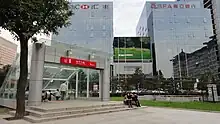

Xi'an has many areas that are easily accessible on foot. In many commercial, residential, educational zones in the city, especially in the shopping and entertainment districts around the Bell Tower, underpasses and overpasses have been built for the safety and convenience of pedestrians.
A bicycle sharing network started operating in Xi'an from the year 2013 and today has 52,000 bikes, used by over 200,000 people per day.[85] Taxi services are numerous, but many citizens of Xi'an still commute to work using the city's 270 official municipal bus routes serviced by a fleet of over 7,800 buses, with an average system-wide ridership of over 4 million people per day.[85] The bus network is complemented by a rapidly expanding subway system that carries over 1.5 million commuters per day.[85] There are more than 2 million registered automobiles[86] in Xi'an; the growing number of personal automobiles also means traffic jams are a common urban issue.
Metro
Line 2, running through the city from north (North Railway Station) to south (Weiqu Nan), was the first line opened to the public on September 16, 2011.[87] Operations began on September 28, 2011.[87] This line is 19.9 kilometers (12.4 miles) long with 17 stations.[88] Line 1 opened on September 15, 2013. As a west–east railway, its 19 stations connect Houweizhai and Fangzhicheng. Line 3 runs from northeast (Baoshuiqu) to southwest (Yuhuazhai) and opened on November 8, 2016. Line 4, which is basically parallel to Line 2 on its east except for the northern parts, runs from the North Square of the North Railway Station [Beikezhan (Beiguangchang)] to south (Hangtianxincheng) and was available publicly on December 26, 2018.[89] Line 5 opened on December 28, 2020. This line is 41.6 kilometers long, with 31 stations from Matengkong to Chuangxingang.[90]
The subway system covers some of the most famous attractions, such as Banpo Museum (Banpo Station, Line 1), Bell and Drum Tower (Line 2), Fortifications of Xi'an (Line 2), the Giant Wild Goose Pagoda (Line 3 and Line 4), the Daminggong National Heritage Park (Line 4) and Shaanxi History Museum (Line 2, 3 and 4), etc.[91]
The first metro departure time for Line 1, 2, 3 and 4 is 6:00, the last metro departure time for Line 3 and 4 is 23:00, for Line 1 is 23:30, and for Line 2 is 23:50.[92]
On December 30, 2008, a fire accident occurred that was extinguished within an hour and all workers evacuated safely. Sixty-six hours later, on January 2, another fire occurred at another station on Line 2.[93]
Rail
Xi'an's rail station, located just north of Xi'an's walled city, is one of the eight major national rail stations and the main rail hub of Shaanxi Province. The new Xi'an North railway station, situated a few miles to the north, is the station for the high-speed trains of the Zhengzhou–Xi'an High-Speed Railway. With 34 platforms, it is the largest railway station in Northwest China.[94] Construction of the station began on September 19, 2008.[95] The station was opened on January 11, 2011.[94] As of May 2012, Xi'an North Station is served only by the fast (G-series and D-series) trains running on the Zhengzhou–Xi'an high-speed railway; one of them continues south to Hankou.[96] The city's other stations include Xi'an West, Xi'an East, Xi'an South, Sanmincun, and Fangzhicheng railway stations.
Xi'an Railway Station covers 597,000 square meters (6,430,000 square feet), has 5 passenger platforms, and 24 tracks. It provides 112 services to 80 000 people daily. Among the destinations served by direct trains from Xi'an are Beijing, Zhengzhou, Lanzhou, Baoji, and Mount Hua. China Railway High-speed 2 now run an express services from Xi'an to Baoji and Xi'an to Zhengzhou; with a total running time to Baoji of under 90 minutes, and 2 hours to Zhengzhou. The Zhengzhou–Xi'an high-speed railway also serves Xi'an. Construction work began on September 25, 2005, the railway opened for service on February 6, 2010.[97][98] The railway has made air service between Zhengzhou and Xi'an uncompetitive. All passenger flights between the two cities were suspended within 48 days of start of regular high-speed rail service.[99]
Air
Xi'an Xianyang International Airport (airport code: XIY) is the major airport serving the city and it is the largest airport in the northwestern part of China. It is 25 miles northwest of Xi'an city center, and 8 miles northeast of the center of Xianyang.[100] China Eastern Airlines, Hainan Airlines and China Southern Airlines are the main airlines using the airport. Terminal 3 and the second runway were opened on May 3, 2012.[101]
Other than linking to most Chinese cities, the airport also has flights to several major Asian cities. One incident, however, is in 1994, when China Northwest Airlines flight 2303 broke up in mid-air and crashed near Xi'an en route to Guangzhou.[102][103] A maintenance error was responsible. All 160 people on board died. As of 2016, it remains the deadliest airplane crash ever to occur in mainland China.[104]
Culture and religion
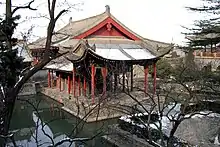
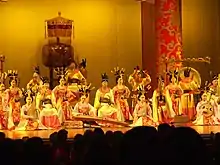
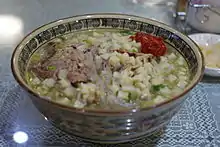
Resident artists
Xi'an is home to contemporary Chinese stars such as Xu Wei,[105] Zhang Chu and Zheng Jun.
Xi'an cuisine
Yangrou paomo (flat bread soaked in lamb soup; simplified Chinese: 羊肉泡馍; traditional Chinese: 羊肉泡饃; pinyin: Yángròu pàomó)[106] is a well known Xi'anese dish.
Liang pi (cold rice noodles; simplified Chinese: 凉皮; traditional Chinese: 涼皮; pinyin: liángpí) are wheat or rice noodles served cold with vinegar and chili oil.
Biangbiang mian, also known as youpo chemian (simplified Chinese: 油泼扯面; traditional Chinese: 油潑扯麵; pinyin: Yóupō chěmiàn), are thick and long hand-pulled noodles, typically served with red hot pepper.
Roujiamo (meat buns; simplified Chinese: 肉夾馍; traditional Chinese: 肉夾饃; pinyin: Ròujiāmó) is a bun filled with pork.
Qinqiang
Qinqiang (Voice of Qin) is the oldest and most extensive of the four major types of Chinese opera.[107][108][109] Another one would be the Empress of the Great Tang is China's first Tang Dynasty dance and music show. The story is based on the life of the famous Chinese historical figure, Empress Wu Zetian of the Tang Dynasty. Through live performances by a classical Chinese orchestra and state-of-the-art stage design, this show will take you back to the glory of the legendary Empress Wu Zetian and the Great Tang Empire.
Chinese traditional religion and Taoism

The most influential religions in Xi'an are the Chinese traditional religion and Taoist schools, represented by many major and minor temples. Among these there are a City God Temple, completely reconstructed in the 2010s, and a Temple of Confucius.
Christianity
The first recorded Christian missionary in China was Alopen, a Syriac-speaker, who arrived in Xi'an (then known as Chang'an) in 635 along the Silk Road. The Nestorian Stele, now located in Xi'an's Beilin Museum, is a Tang Chinese stele erected in 781 that documents the 150 years of early Christianity in China following Alopen.[35] It is a 279-centimeter-tall (110-inch) limestone block with text in both Chinese and Syriac describing the existence of Christian communities in several cities in northern China. The Daqin Pagoda, a Buddhist pagoda in Zhouzhi County of Xi'an, has been suggested to have originally been a Nestorian Christian church from the Tang Dynasty.[110]
Baptist missionaries from England ran a hospital in Xi'an.[111] In 1892, Arthur Gostick Shorrock[112] and Moir Duncan[113] founded the Sianfu Mission, in present-day Xi'an.[114][115][116]
Islam
Xi'an has a minority Muslim community, most of these Muslims are from the Hui group, there are an estimated 50,000 Hui Muslims in Xi'an.[117] There are seven mosques in Xi'an, the best known being the Great Mosque.[118]
Economy

As part of the China Western Development policy, Xi’an became a major target for accelerated attention. From 1997 to 2006, the industrial output value of Xi’an's service industry increased at an annual average rate of 13 percent, compared to traditional service industries of 0.74 percent, representing a growth from US$8.113 billion to US$25.85 billion.[119] Xi'an is the largest economy of the Shaanxi province, with a GDP of 324.1 billion Yuan in 2010. On average this value increases by 14.5 percent annually, and accounts for approximately 41.8 percent of Shaanxi's total GDP.[119][120] At least fifty-eight countries have established over 2,560 enterprises in Xi'an, including nineteen of the Fortune 500 enterprises. These include ABB, Mitsubishi, Panasonic, Toshiba, Fujitsu, Coca-Cola Company and Boeing.[121] Xi'an's capacity in information technology, advanced materials, aerospace, energy, and chemical engineering was highlighted in the western development policies in the Guiding Opinions of the Central Committee of the Communist Party of China and the State Council on Development of the West in the New Era and Forming a New Pattern.[60]: 186
In 2020, Xi'an was ranked as a Beta- (global second tier) city by the Globalization and World Cities Research Network.[10] Xi'an is also one of the world's top 100 financial centers, according to the Global Financial Centres Index.[12]
Important industries include equipment manufacturing, tourism, and service outsourcing.[122] The manufacturing industry had an annual output of RMB 36.5 billion, accounting for 44.5 percent of the city's total.[120] Furthermore, as one of China's four ancient capitals,[123] Xi'an's many cultural sites, including the Terracotta Army, the City Wall of Xi'an, and the Famen Temple, make tourism an important industry as well. In 2010, 52 million domestic tourists visited Xi'an, earning a total income of RMB 40.52 billion. On average, revenue increases by 36.4 percent per year, and foreign-exchange earnings (530 million in 2009) increase by around 35.8 percent.[120]
Xi'an is also one of the first service outsourcing cities in China, with over 800 corporations in the industry. The city's output value from this sector exceeded RMB 23 billion in 2008. Employment in the sector doubled from 1997 to 2006, from a base of 60,000, and computer consulting also doubled from 16,000 to 32,000.[119] As a result of the importance of the software-outsourcing industry, the city planned construction of a Software New Town, which is scheduled to be completed in 2015 with 30 billion RMB investment.[120] Other major export goods include lighting equipment and automobile parts, while its major import goods are mechanical and electrical products. Internationally, Xi'an's largest trade partner is the United States.[120]
Software and technological industries
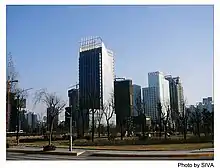
The major industrial zone in Xi'an is the Xi'an Economic and Technological Development Zone. The Jiangcungou landfill in Xi'an was China's largest landfill site before its closure in 2019.[124]
The growing economy of the city also supports the development of a software industry, and the city is a pioneer in software industry in China. The Xi'an Software Park within the Xi'an Hi-Tech Industries Development Zone (XDZ) has attracted over 1,085 corporations and 106,000 employees as of 2012.[125] Xi'an is described as having" large pool of cheap human resources from the 100 universities in the area, it hoovers up around 3,000 computer graduates every year, each earning approximately $120 a month—half the wages for the equivalent job in Beijing."[126][127]
Aerospace industry
In November 2006, Xi'an and the China Aerospace Science and Technology Corporation jointly set up Xi'an Aerospace Science and Technology Industrial Base. From its establishment, the base has focused on the development of the civil space industry, including equipment manufacturing, software and service outsourcing, new materials and solar photovoltaics.
Apart from the core area, the base will cover Xi'an and the Guanzhong area and the expansion zone will reach other parts of Northwest China and Southwest China. It is expected that by 2012 the total industry output can reach 2.8 billion us dollars with about 10 to 20 brand products with intellectual property rights and 5 to 8 products with global competitiveness.
In 2008, after the launch of the initial aerospace center in Shanghai, the PRC is constructing another civil aerospace center in the Shaanxi province. The State Development and Reform Commission approved the planning of Xi'an National Civil Aerospace Industrial Base on December 26, 2007. The National Civil Aerospace Industrial Base of Xi'an, set to cover 23 km2 (8.9 sq mi), will focus on developing satellites, new materials, energies, IT and other technologies for civil applications.[128]
Education and research

Xi'an has many highly-ranked educational institutions, with the seven universities listed in 147 National Key Universities under the Double First Class University Plan ranking fourth nationwide (tie) with Guangzhou, Wuhan and Chengdu (only after Beijing, Shanghai and Nanjing). There are a total of 60 universities in the city,[129] with the most famous one being the Xi'an Jiaotong University (西安交通大学), which was ranked 100-150 worldwide.[130] Other ones also include the Northwestern Polytechnical University (西北工业大学), Xidian University (西安电子科技大学), Chang'an University (长安大学), Northwest University (西北大学), Northwest University of Political Science and Law (西北政法大学) and; Shaanxi Normal University (陕西师范大学).
The city was ranked 138th globally by the QS Best Student Cities Rankings in 2023.[131]
Xi'an is a world leading city for scientific research and as of 2022, it ranked among the world's top 30 cities and China's top 10 cities by scientific research output by the Nature Index.[132] It ranked first in West China region, with a combined population of almost 300 million. The city also hosted the 2011 World Horticultural Exposition.[133]
Tourism


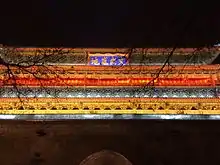


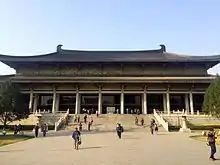
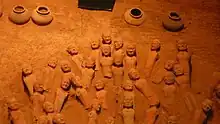

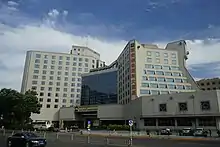
Sites
Because of the city's many historical monuments and a plethora of ancient ruins and tombs in the vicinity,[18] tourism has been an important component of the local economy, and the Xi'an region is one of the most popular tourist destinations in China.[18]
The city has many important historical sites, and some are ongoing archaeological projects, such as the Mausoleum of Qin Shi Huang and his Terracotta Army. There are several burial mounds, tombs of the Zhou dynasty kings located in the city.[16] Xi'an also contains some 800 royal mausoleums and tombs from the Han dynasty,[134] with some of them yielding hundreds of sculpted clay soldiers, and remains of sacrificial temples from the Han era.[134] The city has numerous Tang dynasty pagodas and is noted for its history museum and its stele forest, which is housed in an 11th-century Confucian temple containing large stone tablets from various dynasties.[134]
Some of the most well-known sites in Xi'an are:
- The city is surrounded by a well-preserved city wall which was re-constructed in the 14th century during the early Ming dynasty and was based on the inner imperial palace of Tang dynasty.
- The Mausoleum of Qin Shi Huang and his Terracotta Army are located 40 km (25 mi) to the east of the city center, in the city's suburbs.
- The Bell Tower and Drum Tower, both are located at the city's central axis
- The city's Muslim Quarter, which is home to the Great Mosque of Xi'an
- The Giant Wild Goose Pagoda and Small Wild Goose Pagoda are both spectacular towers and both are well over 1,000 years old and have survived great earthquakes.
- The Stele Forest is famous for its numerous historic inscriptions and stoneworks.[135]
- The Famen Temple and its towering pagoda located 120 kilometers (75 miles) west of Xi'an.
- Xi Ming Temple
- Wolong Temple at Kaitong lane
- Xingjiao Temple at Shaolin Yuan
- Jianfu Temple
- The Banpo Neolithic village
- The Shaanxi History Museum, which has a large collection of historical artifacts
- Huaqing Hot Springs, at the foot of Mt. Li, have a history of 6,000 years, the adjacent Huaqing Palace has a history of 3,000 years. Ranked among the Hundred Famous Gardens in China, it also has the status as a National Cultural Relic Protection Unit and a National Key Scenic Area.
- Daming Palace National Heritage Park, site of the former royal residence of the Tang dynasty emperors
- Mount Li National Forest Park
- Mount Zhongnan National Forest Park
Sports
Famous former professional sports teams in Xi'an include:
- Chinese Jia-A League
- Shaanxi National Power (moved to Ningbo and renamed themselves Ningbo National Power in 2004)
- Chinese Football Association Super League
- Shaanxi Baorong Chanba (moved to Guiyang and renamed themselves Guizhou Renhe in 2012)
- Chinese Basketball Association
- Shaanxi Dongsheng (moved to Foshan and renamed themselves Foshan Dralions in 2010).
Media
Television and radio
- China Central Television's channel 1 through 12 is broadcast nationwide.
- Shaanxi Television (SXTV), provincial station, broadcasts on eight channels as well as a satellite channel for other provinces.
- Shaanxi Radio broadcasts music and news.
International relations
Xi'an's twin towns and sister cities are:
|
|
References
Citations
- "China: Shaanxi (Prefectures, Cities, Districts and Counties) - Population Statistics, Charts and Map". Archived from the original on January 3, 2022. Retrieved January 3, 2022.
- "Xi'an". The American Heritage Dictionary of the English Language (5th ed.). HarperCollins. Retrieved April 14, 2019.
- "Xi'an". Collins English Dictionary. HarperCollins. Archived from the original on April 14, 2019. Retrieved April 14, 2019.
- "Xian" Archived April 14, 2019, at the Wayback Machine (US) and "Xian". Lexico UK English Dictionary. Oxford University Press. Archived from the original on March 22, 2020.
- "Xi'an". Merriam-Webster.com Dictionary. Retrieved April 14, 2019.
- "Illuminating China's Provinces, Municipalities and Autonomous Regions". PRC Central Government Official Website. Archived from the original on December 24, 2014. Retrieved May 17, 2014.
- 最新中国城市人口数量排名(根据2010年第六次人口普查). www.elivecity.cn. 2012. Archived from the original on March 3, 2015. Retrieved May 27, 2014.
- 国家统计局. "经济社会发展统计图表:第七次全国人口普查超大、特大城市人口基本情况". 求是. Archived from the original on September 17, 2021. Retrieved May 3, 2022.
- 中央机构编制委员会印发《关于副省级市若干问题的意见》的通知. 中编发[1995]5号. 豆丁网. Archived from the original on May 29, 2014. Retrieved May 28, 2014.
- "GaWC - The World According to GaWC 2020". www.lboro.ac.uk. Archived from the original on August 24, 2020. Retrieved June 25, 2021.
- 上海证券报 (May 21, 2021). "中国百强城市榜单发布,你的城市上榜了吗?". finance.sina.com.cn. Archived from the original on June 25, 2021. Retrieved June 25, 2021.
- "The Global Financial Centres Index 28" (PDF). Long Finance. September 2020. Archived (PDF) from the original on October 9, 2022. Retrieved September 26, 2020.
- "Leading 200 science cities | Nature Index 2022 Science Cities | Supplements | Nature Index". www.nature.com. Archived from the original on November 26, 2022. Retrieved November 26, 2022.
- "US News Best Global Universities Rankings in Xi'an". U.S. News & World Report. October 26, 2021. Archived from the original on October 30, 2021. Retrieved October 26, 2021.
- "Nature Index 2018 Science Cities | Nature Index Supplements | Nature Index". www.natureindex.com. Archived from the original on November 5, 2021. Retrieved October 15, 2020.
- "Xi'an". Encarta. 1993–2008. September 3, 2008. Archived from the original on February 28, 2008. Retrieved February 6, 2016.
- Xi'an Municipal People's Government (October 15, 2020). "Xi'an Makes a Top Tourist Attraction in National Day Golden Week". Archived from the original on May 3, 2022. Retrieved May 3, 2022.
- "Xi'an". Encyclopædia Britannica. Archived from the original on December 4, 2008. Retrieved September 3, 2008.
- Du Halde (1736), pp. 220–1; Du Halde (1741), pp. 227–8
- Stanford (1917), p. 13 & Index, p. 11
- 《中国古今地名大词典》 [The Big Dictionary of Old and Current Chinese Placenames], Shanghai: Shanghai Cishu Chubanshe, 2005, p. 1540
- Yang, Xiaoping (2010). "Climate Change and Desertification with Special Reference to the Cases in China". Changing Climates, Earth Systems and Society. pp. 177–187. doi:10.1007/978-90-481-8716-4_8. ISBN 978-90-481-8715-7.
- Stark, Miriam T (April 15, 2008). "East Asian plant domestication". Archaeology of Asia. John Wiley & Sons. pp. 77–95. ISBN 9781405153034. Archived from the original on August 13, 2023. Retrieved November 15, 2015.
- Fuller, Dorian Q; Qin, Ling; Harvey, Emma (2008). "A Critical Assessment of Early Agriculture in East Asia, with emphasis on Lower Yangzte Rice Domestication" (PDF). Pragdhara: 17–52. Archived (PDF) from the original on September 24, 2015. Retrieved May 28, 2014.
- Meng, Y; Zhang, HQ; Pan, F; He, ZD; Shao, JL; Ding, Y (2011). "Prevalence of dental caries and tooth wear in a Neolithic population (6700-5600 years BP) from northern China". Archives of Oral Biology. 56 (11): 1424–35. doi:10.1016/j.archoralbio.2011.04.003. PMID 21592462.
- "Banpo Museum in Xi'an". chinamuseums.com. Archived from the original on January 31, 2018. Retrieved July 29, 2013.
- Third scroll of the Chang'an Annals (长安志) interpreted by Huangfu Mi in his Age of the Kings (book) (帝王世紀)
- 2011年上海中西书局出版《清华大学藏战国竹简》(贰):周幽王取妻于西申,生平王,王或(又)取褒人之女,是褒姒,生伯盘。褒姒嬖于王,王与伯盘逐平王,平王走西申。幽王起师,回(围)平王于西申,申人弗畀,曾人乃降西戎,以攻幽王,幽王及伯盘乃灭,周乃亡。邦君、诸正乃立幽王之弟余臣于虢,是携惠王。立廿又一年,晋文侯仇乃杀惠王于虢。周亡王九年,邦君诸侯焉始不朝于周,晋文侯乃逆平王于少鄂,立之于京师。三年,乃东徙,止于成周,晋人焉始启于京师,郑武公亦正东方之诸侯。
- 《左传·僖公二十二年》:初,平王之东迁也,辛有适伊川,见被发而祭于野者,曰:"不及百年,此其戎乎!其礼先亡矣。"秋,秦、晋迁陆浑之戎于伊川。
- 中国古今地名大词典 (in Simplified Chinese). Shanghai: Shanghai Lexicographical Publishing House. 2005. p. 2134.
- O. Louis Mazzatenta (October 9, 2009). "Emperor Qin's Terracotta Army". National Geographic. Archived from the original on May 28, 2014. Retrieved May 28, 2014.
- "Weiyang Palace: the Largest Palace Ever Built on Earth". Archived from the original on March 3, 2016. Retrieved November 4, 2014.
- 西安历史 (in Chinese (China)). Archived from the original on February 11, 2011. Retrieved February 22, 2011.
- Kiang, 12.
- Hill, Henry, ed (1988). Light from the East: A Symposium on the Oriental Orthodox and Assyrian Churches. Toronto, Canada. pp. 108–109
- Jenkins, Peter (2008). The Lost History of Christianity: the Thousand-Year Golden Age of the Church in the Middle East, Africa, and Asia – and How It Died. New York: Harper Collins. pp. 65. ISBN 978-0-06-147280-0.
- Elliott, Mark C. (2001). The Manchu Way: The Eight Banners and Ethnic Identity in Late Imperial China. Stanford University Press. p. 280. ISBN 9780804746847. Archived from the original on April 12, 2023. Retrieved April 11, 2023.
- Elliott, Mark C. (2001). The Manchu Way: The Eight Banners and Ethnic Identity in Late Imperial China. Stanford University Press. p. 281. ISBN 9780804746847. Archived from the original on April 12, 2023. Retrieved April 11, 2023.
- Elliott, Mark C. (2001). The Manchu Way: The Eight Banners and Ethnic Identity in Late Imperial China. Stanford University Press. ISBN 9780804746847. Archived from the original on April 29, 2023. Retrieved April 11, 2023.
- Elliott, Mark C. (2001). The Manchu Way: The Eight Banners and Ethnic Identity in Late Imperial China. Stanford University Press. p. 289. ISBN 9780804746847. Archived from the original on April 12, 2023. Retrieved April 11, 2023.
- YZMaZPZZ (Yongzheng chao Manwen zhupi zouzhe) 1 22 1 , Sumurji, YZ7.R7.24.
- Elliott, Mark C. (2001). The Manchu Way: The Eight Banners and Ethnic Identity in Late Imperial China. Stanford University Press. p. 224. ISBN 9780804746847. Archived from the original on April 12, 2023. Retrieved April 11, 2023.
- Elliott, Mark C. (2001). The Manchu Way: The Eight Banners and Ethnic Identity in Late Imperial China. Stanford University Press. p. 177. ISBN 9780804746847. Archived from the original on April 29, 2023. Retrieved April 11, 2023.
- https://www.demographic-research.org/volumes/vol38/34/38-34.pdf Archived April 5, 2023, at the Wayback Machine Demographic Research Volume 38, Article 34, Pages 929-966 Published 9 March 2018 http://www.demographic-research.org/Volumes/Vol38/34/ Archived April 16, 2023, at the Wayback Machine DOI: 10.4054/DemRes.2018.38.34 Research Article Interethnic marriage in Northeast China, 1866–1913 Bijia Chen Cameron Campbell Hao Dong p 937
- hRoss, Edward Alsworth (1911). The Changing Chinese: The Conflict of Oriental and Western Culture in China. p. 280. Archived from the original on April 29, 2023. Retrieved April 11, 2023.
- Ross, Edward Alsworth (1911). The Changing Chinese: The Conflict of Oriental and Western Cultures in China. p. 275. Archived from the original on June 21, 2023. Retrieved June 21, 2023.
- Ernest Frank Borst-Smith, Caught in the Chinese Revolution: a record of risks and rescue. London: T. Fisher Unwin, 1912.
- Crossley, Pamela Kyle (1991). Orphan Warriors: Three Manchu Generations and the End of the Qing World (illustrated, reprint ed.). Princeton University Press. p. 197. ISBN 0691008779. Archived from the original on August 13, 2023. Retrieved May 10, 2019.
- Backhouse, Sir Edmund; Otway, John; Bland, Percy (1914). Annals & Memoirs of the Court of Peking: (from the 16th to the 20th Century) (reprint ed.). Houghton Mifflin. p. 209.
- The Atlantic, Volume 112. Atlantic Monthly Company. 1913. p. 779. Archived from the original on August 13, 2023. Retrieved May 10, 2019.
- The Atlantic Monthly, Volume 112. Atlantic Monthly Company. 1913. p. 779.
- Rhoads, Edward J. M. (2000). Manchus and Han: Ethnic Relations and Political Power in Late Qing and Early Republican China, 1861–1928 (illustrated, reprint ed.). University of Washington Press. p. 192. ISBN 0295980400.
- Rhoads, Edward J. M. (2000). Manchus and Han: Ethnic Relations and Political Power in Late Qing and Early Republican China, 1861–1928 (illustrated, reprint ed.). University of Washington Press. p. 193. ISBN 0295980400.
- Fitzgerald, Charles Patrick; Kotker, Norman (1969). Kotker, Norman (ed.). The Horizon history of China (illustrated ed.). American Heritage Pub. Co. p. 365. ISBN 9780828100052.
- Edward J. M. Rhoads (2000). Manchus and Han: Ethnic Relations and Political Power in Late Qing and Early Republican China, 1861–1928. University of Washington. p. 191. ISBN 9780295980409. Archived from the original on June 21, 2023. Retrieved June 21, 2023.
- Guo Rugui, 《中国抗日战争正面战场作战记》 ,第二部分:从"九一八"事变到西安事变 绥远抗战的巨大影响和军事上的经验
- 蔡, 乔治. "第五大队副队长 岑泽鎏". flyingtiger-cacw.com. Archived from the original on February 9, 2021. Retrieved April 8, 2021.
1938年3月8日,在山西风陵渡炸敌。11日,参加西安空战。4月26日,在湖北孝感与僚机合力击落敌机一架。29日,在武汉击伤敌机一架。5月11日,在安徽蒙城炸毁敌军阵地。20日,在河南仪封炸敌阵地,座机中弹百余发,仍勉力飞回。
- Yang, HX (October 13, 2016). "Why did not the Japanese army occupied Shaanxi?". www.bestchinanews.com. Archived from the original on May 13, 2021. Retrieved April 8, 2021.
While Xian became one of the main targets of the Japanese bombing campaign of the 8 years of war, with Japanese aircraft bombing of Shaanxi 560 times, injuring and killing thousands of people, the Japanese basically have not been able to take Xian, nor occupy any land in Shaanxi.
- 西安市历史沿革 (in Simplified Chinese). City of Xi'an. Archived from the original on July 7, 2011. Retrieved February 22, 2011.
- Marquis, Christopher; Qiao, Kunyuan (2022). Mao and Markets: The Communist Roots of Chinese Enterprise. New Haven: Yale University Press. doi:10.2307/j.ctv3006z6k. ISBN 978-0-300-26883-6. JSTOR j.ctv3006z6k. OCLC 1348572572. S2CID 253067190.
- 打砸抢烧不是爱国是害民. Beijing Youth Daily (in Simplified Chinese). September 16, 2012. Archived from the original on April 22, 2017. Retrieved September 16, 2012.
- "Xi'an Protesters Overturn Cars". Retrieved September 17, 2012.
- "Anti-Japan Protests In China Swell, Turn Violent". Huffington Post. September 15, 2012. Archived from the original on March 4, 2016. Retrieved September 17, 2012.
- Taipei, Rhoda Kwan in (December 27, 2021). "Covid cases rise in Xi'an as China battles biggest community outbreak since 2020". the Guardian. Archived from the original on January 5, 2022. Retrieved January 6, 2022.
- "13 million people under lockdown in Xi'an, China". NHK. Archived from the original on December 25, 2021. Retrieved December 27, 2021.
- Cheng, Evelyn (December 22, 2021). "Major Chinese city locks down to control Covid outbreak". CNBC. Archived from the original on January 4, 2022. Retrieved January 3, 2021.
- "Tales of anguish emerge from China's locked-down Xian, as hospitals demand patients be covid-free". Washington Post. ISSN 0190-8286. Archived from the original on January 5, 2022. Retrieved January 6, 2022.
- "China is determined to make the Winter Olympics go smoothly". Economist (published January 29, 2022). January 26, 2022. Archived from the original on February 2, 2022. Retrieved February 2, 2022.
- 《史记·留侯世家》
- "无标题文档". Archived from the original on March 18, 2013. Retrieved February 18, 2013.
- "Extreme Temperatures Around the World". Archived from the original on August 4, 2014. Retrieved February 21, 2013.
- 中国气象数据网 – WeatherBk Data (in Simplified Chinese). China Meteorological Administration. Archived from the original on September 5, 2018. Retrieved July 3, 2023.
- CMA台站气候标准值(1991-2020) (in Chinese). China Meteorological Administration. Retrieved April 11, 2023.
- 中国气象局 国家气象信息中心 (in Simplified Chinese). China Meteorological Administration. June 2011. Archived from the original on July 16, 2009. Retrieved March 17, 2009.
- NTSC Archived March 4, 2016, at the Wayback Machine 国家授时中心简介
- 西安市2015年国民经济和社会发展统计公报. www.xatj.gov.cn/. Archived from the original on June 4, 2016. Retrieved May 12, 2016.
- 西安人口 [Xi'an population] (in Chinese). City of Xi'an. Archived from the original on March 22, 2007. Retrieved May 16, 2007.
- OECD Urban Policy Reviews: China 2015, OECD READ edition. OECD. April 18, 2015. p. 37. doi:10.1787/9789264230040-en. ISBN 9789264230033. ISSN 2306-9341. Archived from the original on March 27, 2017. Retrieved December 8, 2017.Linked from the OECD here Archived December 9, 2017, at the Wayback Machine
- "World urban areas" (PDF). Archived (PDF) from the original on May 3, 2018. Retrieved November 16, 2017.
- 西安市2010年第六次全国人口普查主要数据公报 (in Chinese). Xi'an Evening News (西安晚报). May 25, 2011. Archived from the original on February 20, 2014. Retrieved July 3, 2014.
- People's Republic of China County-level Division Population Statistics (《中华人民共和国全国分县市人口统计资料2010》).
- 国家统计局统计用区划代码. National Bureau of Statistics of the People's Republic of China. 2012. Archived from the original on April 7, 2012. Retrieved January 27, 2013.
- Cáo Yùzhēn 曹玉珍, ed. (2011). Guìyáng tǒngjì niánjiàn 2011 贵阳统计年鉴2011 [Guiyang Statistical Yearbook 2011] (in Chinese). Zhōngguó tǒngjì chūbǎn shè. ISBN 978-7-5037-6310-6.
- Chén Yuèliáng 陈越良, ed. (2011). Zhōngguó Mínzhèng Tǒngjì Niánjiàn 2011 中国民政统计年鉴2011 [China Civil Affairs' Statistical Yearbook 2011]. Beijing: Zhōngguó tǒngjì chūbǎn shè. ISBN 978-7-5037-6306-9.
- -中国公交信息网. www.bus-info.cn. Archived from the original on August 1, 2017. Retrieved July 3, 2017.
- 小雪, 翟 (July 4, 2014). 西安机动车数量突破200万辆. 西安晚报. Archived from the original on September 12, 2014.
- 西安地铁二号线开通 西安迈入"地铁时代" [Xi'an Metro line brings Xi'an into the "metro era"]. China National Radio (in Simplified Chinese). Beijing. September 16, 2006. Archived from the original on October 8, 2012. Retrieved May 28, 2014.
- 市政府召开西安地铁开通试运营新闻发布会 (in Simplified Chinese). September 16, 2011. Archived from the original on November 14, 2011. Retrieved October 3, 2012.
- "Xian: the Building of Subway to Start This Year". Travel China Guide. September 14, 2006. Archived from the original on January 3, 2014.
- "西安地铁5号线6号线一期9号线开通运营 王浩胡润泽韩松出席仪式 李明远宣布通车". Xi'an Government. November 29, 2020. Archived from the original on November 23, 2021. Retrieved November 23, 2021.
- "Xi'an Transportation" ChinaTour.Net Archived April 2, 2015, at the Wayback Machine Accessed December 4, 2014
- 一、二、三、四号线首末班车时刻表. Xi'an Metro. Archived from the original on January 3, 2019. Retrieved February 25, 2019.
- "Subway Collapse Kills Two in Xi'an". CRIENGLISH.com. China Radio International. August 3, 2009. Archived from the original on May 29, 2014. Retrieved May 28, 2014.
- "Growth to continue". Railway Gazette International. DVV Media UK. March 3, 2011. Archived from the original on March 9, 2011. Retrieved May 28, 2014.
- Tang Ru (September 20, 2008). 郑西客运专线西安北站将建成大型综合交通枢纽中心 [Zhengzhou to Xi'an: Xi'an North Passenger Station will be a large-scale transport hub]. China Railway Network (in Chinese). www.railcn.net Corporation. Archived from the original on March 4, 2016. Retrieved February 6, 2016.
- 西安北列车时刻表 [Xi'an North train schedule]. ip138.com. Archived from the original on March 4, 2016. Retrieved December 5, 2018.
- "Zhengzhou-Xi'an high-speed train starts operation". China Daily. February 6, 2010. Archived from the original on February 3, 2015. Retrieved February 6, 2010.
- "High-speed rail linking central, western China starts operation". iStockAnalyst. February 6, 2010. Archived from the original on February 8, 2010. Retrieved February 6, 2010.
- "China express train forces airlines to stop flights". Reuters. March 26, 2010. Archived from the original on March 30, 2010. Retrieved March 28, 2010.
- 陕西年鉴1992 [Shaanxi Yearbook 1992]. Archived from the original on May 29, 2014.
- "Xian Airport opens new terminal building with strong focus on retail growth". Archived from the original on May 23, 2014. Retrieved May 28, 2014.
- Tyler, Patrick E. (June 7, 1994). "et Crash in China Kills 160; Another Flight Is Hijacked". The New York Times. p. A7. Archived from the original on December 27, 2021. Retrieved September 21, 2021.
- News report from the Kingston Gleaner. Archived May 26, 2011, at the Wayback Machine NewspaperArchive.com
- Accident description at the Aviation Safety Network
- "Xu Wei to rock fans in grand concert". Shenzhen Daily. China Daily. July 5, 2005. Archived from the original on September 24, 2015. Retrieved May 28, 2014.
- 陕西小吃-羊肉泡馍. News.xinhuanet.com. Archived from the original on November 26, 2013. Retrieved May 28, 2014.
- "China promove programas diversificados durante o Festival da Primavera". China Radio International. February 8, 2008. Archived from the original on March 4, 2016. Retrieved November 17, 2010. (English Archived November 17, 2015, at the Wayback Machine)
- "Chinese opera The First Emperor transmitted live into theaters worldwide". People's Daily. January 14, 2007. Archived from the original on May 29, 2014. Retrieved November 17, 2010.
- Yuet Chau, Adam (2006). Miraculous response: doing popular religion in contemporary China. Stanford University Press. p. 53. ISBN 9780804767651. Archived from the original on January 2, 2016. Retrieved November 17, 2010.
- Martin Palmer, The Jesus Sutras: Rediscovering the Lost Religion of Taoist Christianity, ISBN 0-7499-2250-8, 2001
- Fleming, Peter (1936) News from Tartary. London: Jonathan Cape; pp. 46–48
- Shorrock, Arthur Gostick (1926). Shensi in Sunshine and Shade. Shanghai: Presbyterian Mission Press.
- "Duncan Papers (Mundus Gateway to missionary collections in the United Kingdom)". Angus Library, Regents Park College. Archived from the original on October 11, 2013. Retrieved August 14, 2013.
- Burt, Ernest Whitby (1925). Fifty Years in China: The Story of the Baptist Mission in Shantung, Shansi, and Shensi, 1875–1925. London: The Carey Press.
- Glover, Richard (1914). Herbert Stanley Jenkins, medical missionary, Shensi, China: with some notices of the work of the Baptist Missionary Society in that country (1914). London: Carey Press. p. 155. ISBN 978-0-524-07100-7. Archived from the original on March 7, 2016. Retrieved November 15, 2015.
- Duncan, Moir Black (1900). The missionary mail to faithful friends and candid critics (the substance of letters written from Shên His). London: Elliot Stock. ISBN 9780524102336.
- Zhang, Zhizhong. 中国七大中心城市人口资源大调查 [Population survey of the seven central cities of China]. National Family Planning Commission. Archived from the original on September 23, 2015. Retrieved August 21, 2013.
- Mosques in Xian Archived April 30, 2017, at the Wayback Machine from www.muslim2china.com
- Walcott, Susan (April 17, 2010). "Xi'an's Maturing Economy". Archived from the original on February 6, 2022. Retrieved June 1, 2013.
- "Xi'an ( Shaanxi ) City Information". August 29, 2011. Archived from the original on May 5, 2015. Retrieved June 1, 2013.
- "City Report: Xi'an". January 17, 2007. Archived from the original on October 3, 2014. Retrieved June 2, 2013.
- "Xi'an Economy". The People's Government of Shaanxi. January 1, 2008. Archived from the original on March 3, 2016. Retrieved June 2, 2013.
- "Xi'an". Lehman, Lee & Xu. Archived from the original on June 29, 2013. Retrieved June 2, 2013.
- "China's mega-dump already full – 25 years early". BBC News. November 15, 2019. Archived from the original on December 3, 2019. Retrieved November 15, 2019.
- "Xi'an software park". www.xdz.com. Archived from the original on February 11, 2018. Retrieved February 10, 2018.
- "People's Daily". Archived from the original on September 4, 2008. Retrieved October 1, 2007.
- Bureau of Commerce of Xi'an Municipal Government Archived October 16, 2012, at the Wayback Machine
- "China military aircraft to see tech "breakthroughs" this year -Xinhua". Reuters. March 11, 2015. Archived from the original on June 30, 2021. Retrieved June 24, 2021.
- "Xi'an | Dynasty, Population, & Facts". Encyclopedia Britannica. Archived from the original on December 25, 2021. Retrieved June 25, 2021.
- "ShanghaiRanking's Academic Ranking of World Universities". www.shanghairanking.com. Archived from the original on August 15, 2022. Retrieved November 30, 2022.
- "QS Best Student Cities Rankings 2023". Top Universities. Archived from the original on July 7, 2022. Retrieved July 20, 2023.
- "Leading 200 science cities | Nature Index 2022 Science Cities | Supplements | Nature Index". www.nature.com. Archived from the original on November 26, 2022. Retrieved November 30, 2022.
- "Xi'an to Host World Horticultural Expo" Archived October 17, 2007, at the Wayback Machine China.org.cn
- "Xi'an". The Columbia Encyclopedia, Sixth Edition. Archived from the original on June 6, 2011. Retrieved September 3, 2008.
- "Six must-see sights of Xi'an | BBC Travel". www.bbc.com. Archived from the original on April 12, 2019. Retrieved April 12, 2019.
- "Sister Cities of Kyoto City". City of Kyoto. Archived from the original on January 21, 2014. Retrieved January 21, 2014.
- "Edinburgh – Twin and Partner Cities". 2008 The City of Edinburgh Council, City Chambers, High Street, Edinburgh, EH1 1YJ Scotland. Archived from the original on March 28, 2008. Retrieved December 21, 2008.
- "Twin and Partner Cities". City of Edinburgh Council. Archived from the original on June 14, 2012. Retrieved January 16, 2009.
- "List of Twin Towns in the Ruhr District" (PDF). Twins2010.com. Archived from the original (PDF) on November 28, 2009. Retrieved October 28, 2009.
- "Города побратимы для Туркменистана - Общество". Гундогар (in Russian). Archived from the original on November 20, 2021. Retrieved September 21, 2021.
- "Sister City Partnership Officially Formalized Between Penang, Malaysia, and Xi'an, Shaanxi Province, China". SEIA. October 27, 2014. Archived from the original on March 6, 2017. Retrieved March 6, 2017.
- "Proposed Twinning of Kota Kinabalu and Xi'an as Sister Cities". Sabah News Today. June 4, 2019. Archived from the original on September 26, 2019. Retrieved September 26, 2019.
- "DBKK, X'ian association to sign MoU". The Borneo Post. July 23, 2019. Archived from the original on September 26, 2019. Retrieved September 26, 2019.
Sources
- Du Halde, Jean-Baptiste (1736), Description Géographique, Historique, Chronologique, Politique, et Physique de l'Empire de la Chine et de la Tartarie Chinoise [A Geographical, Historical, Chronological, Political, and Physical Description of the Empire of China and Chinese Tartary] (in French), The Hague: H. Scheurleer.
- Du Halde, Jean-Baptiste (1741), Brookes, Richard (ed.), The General History of China (3rd ed.), London: J. Watts.
- Heng Chye Kiang (1999), Cities of Aristocrats and Bureaucrats: The Development of Medieval Chinese Cityscapes, Singapore: Singapore University Press, ISBN 978-9971-69-223-0.
- Stanford, Edward (1917), Complete Atlas of China (2nd ed.), London: China Inland Mission.
- Woo, J.K. (1964), "A Newly Discovered Mandible of the Sinanthropus Type: Sinanthropus Lantianensis", Scientia Sinica, 13: 801–811, PMID 14170540.
External links
- Xi'an City Government official website Archived April 7, 2019, at the Wayback Machine
- Xi'an National Hi-tech Development Zone
- Xi'an in Chinese history Archived October 10, 2014, at the Wayback Machine

.jpg.webp)
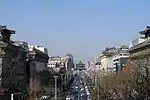
.JPG.webp)
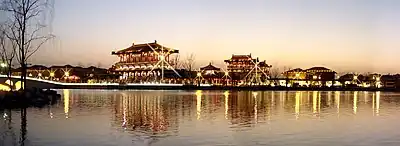



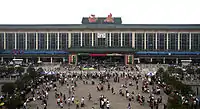
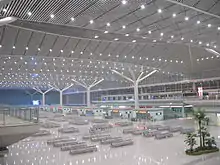
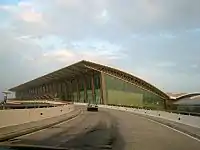

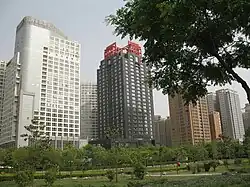

_on_Baoji.jpg.webp)
